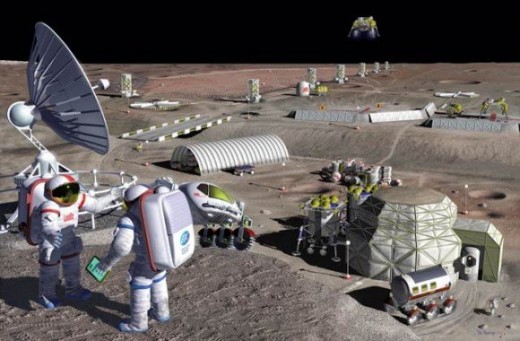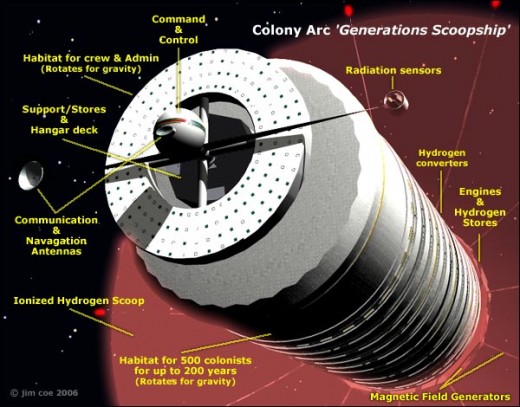Building the Interstellar Space Vehicle
What we know and what we can do






Building in space has already been done with the ISS
After setting up all the necessary pieces for processing raw resources in space, we arrive at the point where we can begin to assemble the interstellar vehicle. We have taken tentative steps by building the International Space Station (ISS). However, the ISS was built entirely from resources launced from earth into low earth orbit. But, once the materials were there, in a prefab form, they were assembled and are now maintained in space in low earth orbit. This then has been a school of sorts of assembling mega projects in outer space, which is what we need to know for future projects. But, so far we have taken already partly manufactured pieces up from earth as pre-fab units to assemble into the ISS. We have as yet to actually make things like windows, girders, rocket engines, solar panels and anything else from scratch with available raw materials in a hard vacuum in a low or zero gravity environment. When it comes to this, we are without direct experience. Making a space colony living quarters and factories will likely begin with pre-fab units launched from earth so that we have a stapping stone to begin manufacture of finished building materials from unprocessed rock and metal asteroids. On earth, everything is made in the context of gravity. In space, except for manufacture on the moon and Mars, most of it will be done in zero gravity. From the practical experience we have on earth, we now have to venture into theoretical methods to process raw materials like rock.
On earth, we have a few main methods for processing raw ore, which may be typically 97 % or higher in waste. In gold production for instance, in most cases, more than 99% of mining material is thrown out as worthless tailings. That is a lot of work for a few flecks of gold! This is the main reason why gold is so valuable as it tales a lot of work to get just a small amount. The same is true for many other resources except for coal and oil, which are found in relatively pure seams and pockets. We won't be looking for coal or oil on the moon anytime soon. On earth, we have to blast mineral containing rock to bits and then crush it to a powder in huge ball mills. The sought after resource is then chemically, electrically or magnetically removed or melted to further purify the desired ore. In some cases, it might even have to be reduced to remove the oxygen. On the moon, what is readly available for easy processing, is loose and finely powdered regolith, much of it the consistency of fine talcum powder. The tough process of crushing in gigantic ball mills has already been done by the incessant pounding of impacts by asteroids, comets, micrometeroids and like earth-moon crossers since time began in the solar system. Regolith is ready made ore bearing dust right for processing by some form of mass spectrometer, chemically, by electroysis or with magnets. Unlike on earth, most of this ore is not in the form of oxides. Thus one of the best places to start is on the moon, which is blanketed with loose dusty regolith containing silicates, aluminum, iron dust, helium 3, lithium and lots of other useful stuff. This blanket is likely dozens of meters deep in places. It is almost everywhere and some earth astronauts proved it by leaving footprints in the fine dust everywhere they walked. The same condition has been found on asteroids we have explored. Some of these are loose aggregates of small rocks and dust. All it takes is to get there and start turning it into something useful.
Once the regolith or dust has been seperated into its pure elements, the next step is to fabricate it into wires, girders, sheets, glass, atmosphere and other basic and useful states. All that is lacking is a source of heat and in space that is not a problem. It has proven to be rather simple to construct a solar collector even on a relatively large scale on earth. These can easily be launched into space to serve as a source of heat. The seperated elements need to be placed either at the focus of the solar collector to melt them directely or the solar collector can produce massive amounts of electrical energy that can be used to melt the elements to fuse and process them into useful articles. When metals and non metal are melted in zero gravity, they do not pool, but will assume the shape of a sphere or nearly so depending on micro gravity influences. The sphere of molten metal or non metal can be rotated to flatten it. It can also be inflated if a tube is inserted into the mass and a non reactive gas is pumped in to inflate it. This differs from processes on earth were gravity causes molten material to pool and flow to the lowest level where casting can be done. In a zero gravity environment, this would have to be done with a scaled up centrifuge system. The molten material would have to be directed into two conterbalanced centrifuge forming systems in order to function properly. Thus we can do what we do on earth in manufacture of basic forms and a few other tricks as well that cannot be done on earth.
A lot of raw material will have to be processed to make just one space colony or an interplanetary or interstellar ship. It would be on the order of making something as large as a cruise ship or air craft carrier at least, or larger. Today, humanity is no stranger to megaprojects as we look at huge technological marvels as the Large Hadron Collider and the Three Gorges Dam. The Interntaional Space Station qualifies as a megaproject and it is in space. The first tenative steps for building space megaprojects have already been taken. As gravity presents no obstacle for moving parts around, vary large sections can be build and manouvered together, just as for the ISS. It might even be possible using large and powerful lasers to hollow out a solid asteroid and refit the hollow interior. As this goes to print, Eros will be doing a close flyby of the earth. If we were ready today, we could pack a crew to the asteroid and set up a base camp to begin mining. There are pure metal asteroids that would be ideal for this. It is reported that some are natural stainless steel. We have laser cannons today that can blast through twelve feet of solid steel as if it were nothing more than a sheet of paper. Thus, one of the essential tools of the trade for space manufacture is one or more of these laser cannons. They could easily be powered from the sun and used for a variety of manufacture tasks. The maser equivalent of this super tool could provide the basis for the energy transmission system needed for fuelless interplanetary ships where the need for onboard fuel can be sharply mininmalized. The high frontier awaits!
NASA sequence of how the ISS was assembled
World's most powerful laser ready for testing
Eros will pas close to earth on Jan. 31st, 2012
- A Manned Mission to the Stars
We have never been short on ideas about how to get into space and travel to the moon and planets. We have already been to the moon and sent probes to every planet in the solar system except Pluto,
Here is a possibility for the collection and use of anti-mater for an anti-matter drive propulsion system
- World's most powerful laser to tear apart the vacuum of space - Telegraph
Using powerful space based lasers, the quantum vacuum state can be perturbed to separate virtual particles long enough to collect the anti-mater components and use this for propulsion.





